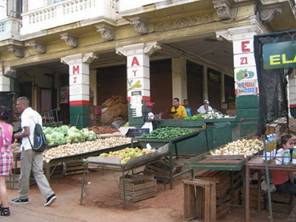
Leafing through the pages of official Cuban publications in recent days, I see articles on the economy in which there are references to plans for the production of potatoes, malanga, yams, yucca, bananas, vegetables, produce and condiments. This is all great news since these efforts will help feed the population. There is very little or no discussion, however, of meat, fish, shellfish or dairy. It seems these are much more difficult to produce, or that their successful production is much less palpable judging by their prolonged absences from store shelves and their inflated prices, which make them unaffordable for most citizens.
Many are aware, at least theoretically, of the four basic food groups, but for the average Cuban these have been historically reduced to two – those that fill the stomach and those that nourish. Perhaps erroneously, the first group includes all simple and complex carbohydrates such as vegetables, grains, cereals and fruits. In the second group are all the meats and the dairy products. In light of the current situation, many would say, “Human beings cannot live on carbs alone.” And they would be right!
Besides, these products are only appropriate for immediate domestic consumption. There is not much of an international market for them since most cannot be stored and are highly perishable. And with the possible exception of the potato, no matter how many tons might be produced, they would never be considered products suitable for export.
It would be interesting to know in detail what has happened to our traditional exports such as sugar, coffee, cocoa, tobacco, shellfish and fruit, some of which have disappeared entirely while supplies of others have been so reduced that we almost no longer speak of them. The collapse of the sugar industry is the most familiar blunder, but there is now talk of something similar happening with nickel, of halting its production and dismantling the old Nicaro Nickel Company because of the mineral’s low price on the world market and the prevalence of corruption within the company. An editorial was published overseas in which the writer noted that “Cuba is like a body that loses a limb every day until, in the end, it is totally dismembered.” This analogy is not far removed from reality and it describes the situation accurately.
The proposed “guidelines,” with all their identifying numbers, are nothing more than that — guidelines. By themselves they will feed no one, nor solve any problem, nor reinforce (much less create) the foundations for a new economy. That is possible only with the participation and efforts of all Cubans — state as well as private enterprises — united to resolve our economic crisis. Clinging to a single path, especially one that has been so clearly shown to be a disaster and the principal cause of the current critical situation, would be to repeat past mistakes. It would mean the irresponsible sacrifice of millions of Cubans, forcing them to live in misery and giving the youngest and most capable an incentive to emigrate. It is never too late to reconsider, though with each passing day there is less time to do so.
September 17 2012
